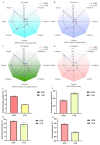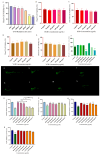A Comparative Study of the Chemical Composition and Skincare Activities of Red and Yellow Ginseng Berries
- PMID: 39459330
- PMCID: PMC11510097
- DOI: 10.3390/molecules29204962
A Comparative Study of the Chemical Composition and Skincare Activities of Red and Yellow Ginseng Berries
Abstract
This study was conducted to investigate the differences in chemical composition between red (RGBs) and yellow ginseng berries (YGBs) and their whitening and anti-aging skincare effects. The differences in the chemical composition between RGB and YGB were analyzed by ultra-high-performance liquid chromatography tandem quadrupole electrostatic field orbit trap mass spectrometry (UHPLC-Q-Exactive-MS/MS) combined with multivariate statistics. An aging model was established using UVB radiation induction, and the whitening and anti-aging effects of the two ginseng berries were verified in vitro and in vivo using cell biology (HaCaT and B16-F10 cells) and zebrafish model organisms. A total of 31 differential compounds, including saponins, flavonoids, phenolic acids, and other chemical constituents, were identified between the two groups. Superoxide dismutase (SOD) activity was more significantly increased (p < 0.05) and malondialdehyde (MDA) content was more significantly decreased (p < 0.01) in RGB more than YGB induced by UVB ultraviolet radiation. In terms of whitening effects, YGB was more effective in inhibiting the melanin content of B16-F10 cells (p < 0.01). The results of zebrafish experiments were consistent with those of in vitro experiments and cell biology experiments. The DCFH fluorescence staining results revealed that both ginseng berries were able to significantly reduce the level of reactive oxygen species (ROS) in zebrafish (p < 0.01). Comparison of chemical composition and skin care activities based on RGB and YGB can provide a theoretical basis for the deep development and utilization of ginseng berry resources.
Keywords: anti-UVB; anti-aging; anti-melanin; chemical composition; ginseng; ginseng berry; whitening.
Conflict of interest statement
Author Jian-Feng Hou is employed by the company Shiqi Biological R&D Centre (Suzhou Industrial Park) Co., Ltd. The remaining authors declare that the research was conducted in the absence of any commercial or financial relationships that could be construed as a potential conflict of interest.
Figures




References
-
- Feng Q., Yan H., Feng Y., Cui L., Hussain H., Park J.H., Kwon S.W., Xie L., Zhao Y., Zhang Z., et al. Characterization of the structure, anti-inflammatory activity and molecular docking of a neutral polysaccharide separated from American ginseng berries. Biomed. Pharmacother. 2024;174:116521. doi: 10.1016/j.biopha.2024.116521. - DOI - PubMed
-
- Lee C.W., You B.H., Yim S., Han S.Y., Chae H.S., Bae M., Kim S.Y., Yu J.E., Jung J., Nhoek P., et al. Change of metformin concentrations in the liver as a pharmacological target site of metformin after long-term combined treatment with ginseng berry extract. Front. Pharmacol. 2023;14:1148155. doi: 10.3389/fphar.2023.1148155. - DOI - PMC - PubMed
Publication types
MeSH terms
Substances
Grants and funding
- No. 20210401108YY, No. YDZJ202201ZYTS207/Jilin Province Science and Technology Development Plan Project
- No. 21ZGY10/Key Technology Research Project of Chang-chun Science and Technology Bureau
- No. 82073969/National Natural Science Foundation of China
- No.020200038/iayi Biochemical Research and Development Center (Suzhou Industrial Park) Co., Ltd
LinkOut - more resources
Full Text Sources
Miscellaneous

